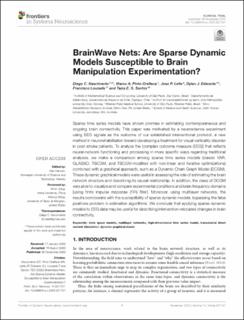| dc.contributor.author | Nascimento, Diego C. | |
| dc.contributor.author | Pinto-Orellana, Marco Antonio | |
| dc.contributor.author | Leite, Joao P. | |
| dc.contributor.author | Edwards, Dylan J. | |
| dc.contributor.author | Louzada, Francisco | |
| dc.contributor.author | Santos, Taiza E. G. | |
| dc.date.accessioned | 2021-05-26T09:39:48Z | |
| dc.date.available | 2021-05-26T09:39:48Z | |
| dc.date.created | 2021-03-17T15:58:23Z | |
| dc.date.issued | 2020-11-26 | |
| dc.identifier.citation | Frontiers in Systems Neuroscience. 2020, 14, (1-14). | en_US |
| dc.identifier.issn | 1662-5137 | |
| dc.identifier.uri | https://hdl.handle.net/11250/2756418 | |
| dc.description.abstract | Sparse time series models have shown promise in estimating contemporaneous and ongoing brain connectivity. This paper was motivated by a neuroscience experiment using EEG signals as the outcome of our established interventional protocol, a new method in neurorehabilitation toward developing a treatment for visual verticality disorder in post-stroke patients. To analyze the [complex outcome measure (EEG)] that reflects neural-network functioning and processing in more specific ways regarding traditional analyses, we make a comparison among sparse time series models (classic VAR, GLASSO, TSCGM, and TSCGM-modified with non-linear and iterative optimizations) combined with a graphical approach, such as a Dynamic Chain Graph Model (DCGM). These dynamic graphical models were useful in assessing the role of estimating the brain network structure and describing its causal relationship. In addition, the class of DCGM was able to visualize and compare experimental conditions and brain frequency domains [using finite impulse response (FIR) filter]. Moreover, using multilayer networks, the results corroborate with the susceptibility of sparse dynamic models, bypassing the false positives problem in estimation algorithms. We conclude that applying sparse dynamic models to EEG data may be useful for describing intervention-relocated changes in brain connectivity. | en_US |
| dc.description.sponsorship | This research was partially supported by CNPq, FAPESP, and CAPES from Brazil. This research was carried out using the computational resources of the Center for Mathematical Sciences Applied to Industry (CeMEAI). | en_US |
| dc.language.iso | eng | en_US |
| dc.publisher | Frontiers Media | en_US |
| dc.relation.ispartofseries | Frontiers in Systems Neuroscience;volume 14 | |
| dc.rights | Navngivelse 4.0 Internasjonal | * |
| dc.rights.uri | http://creativecommons.org/licenses/by/4.0/deed.no | * |
| dc.subject | State space models | en_US |
| dc.subject | Multilayer networks | en_US |
| dc.subject | High-dimensional time series models | en_US |
| dc.subject | Transcranial direct current stimulations | en_US |
| dc.subject | Dynamic graphical models | en_US |
| dc.title | BrainWave Nets: Are Sparse Dynamic Models Susceptible to Brain Manipulation Experimentation? | en_US |
| dc.type | Peer reviewed | en_US |
| dc.type | Journal article | en_US |
| dc.description.version | publishedVersion | en_US |
| dc.rights.holder | © 2020 Nascimento, Pinto-Orellana, Leite, Edwards, Louzada and Santos. | en_US |
| dc.source.articlenumber | 527757 | en_US |
| cristin.ispublished | true | |
| cristin.fulltext | original | |
| cristin.qualitycode | 1 | |
| dc.identifier.doi | https://doi.org/10.3389/fnsys.2020.527757 | |
| dc.identifier.cristin | 1898778 | |
| dc.source.journal | Frontiers in Systems Neuroscience | en_US |
| dc.source.volume | 14 | en_US |
| dc.source.pagenumber | 1-14 | en_US |
| dc.relation.project | FAPESP: 2013/07375-0 | en_US |

